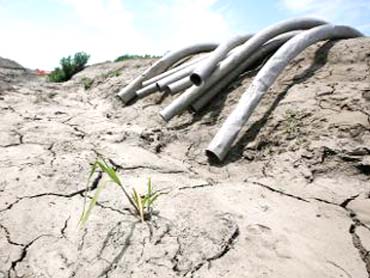
Reuters, Seoul :
North Korea has been hit by what it describes as its worst drought in a century, which could worsen chronic food shortages in a country where the United Nations says almost a third of children under five are stunted because of poor nutrition.
The country suffered a devastating famine in the 1990s and has relied on international food aid, but support has fallen sharply in recent years, because of its curbs on humanitarian workers and reluctance to allow monitoring of food distribution.
The North’s KCNA news agency said late on Tuesday that paddies around the country, including the main rice farming regions of Hwanghae and Phyongan provinces, were drying up for lack of rain. Rice must be partly submerged in order to grow.
“The worst drought in 100 years continues in the DPRK, causing great damage to its agricultural field,” KCNA said, using the short form of the North’s official name, the Democratic People’s Republic of Korea.
South Korea’s Unification Ministry, which handles ties with the North, did not have a comment on Wednesday about the report.
North Korea’s farm production periodically suffers from droughts and floods in the summer, although the state has learned to cut damage by updating farming methods and switching to crops other than rice in recent years.
Thomas Lehman, Denmark’s ambassador to both North and South Korea, told Reuters that on a visit to the North late last month he could “clearly see” attempts to deal with the drought in its fields.
“The lack of water has created a lot of damage to the so-called spring crop, and the rice planting is extremely difficult without sufficient water,” said Lehman, who has spoken to U.N. officials about the drought, and visited drought-hit areas.
North Korea has mounted a campaign encouraging the public to help out on farms, and is using mobile water pumps run on diesel and longer pipes to draw water into fields.
“Farm managers reported receiving training in dry rice planting techniques and other measures that they were trying to conserve water,” said Linda Lewis of the American Friends Service Committee, a group that runs farm projects in the North.
The U.N. resident coordinator for North Korea, Ghulam Isaczai, warned in a Reuters interview last month of a looming crisis due to last year’s drought, caused by the lowest rainfall in 30 years.
At the time, Isaczai said he thought the food situation would not be as bad as in previous major droughts, since communities were now more resilient and might have reserves.
In April, the United Nations called for $111 million to fund crucial humanitarian needs this year in North Korea, which it said remains drastically under-funded.
Funding for U.N. agencies in North Korea fell to less than $50 million in 2014, from $300 million in 2004.
North Korea relies heavily on hydroelectric power and suffers from chronic electricity shortages, which can be exacerbated by periods of no rain.
North Korea has been hit by what it describes as its worst drought in a century, which could worsen chronic food shortages in a country where the United Nations says almost a third of children under five are stunted because of poor nutrition.
The country suffered a devastating famine in the 1990s and has relied on international food aid, but support has fallen sharply in recent years, because of its curbs on humanitarian workers and reluctance to allow monitoring of food distribution.
The North’s KCNA news agency said late on Tuesday that paddies around the country, including the main rice farming regions of Hwanghae and Phyongan provinces, were drying up for lack of rain. Rice must be partly submerged in order to grow.
“The worst drought in 100 years continues in the DPRK, causing great damage to its agricultural field,” KCNA said, using the short form of the North’s official name, the Democratic People’s Republic of Korea.
South Korea’s Unification Ministry, which handles ties with the North, did not have a comment on Wednesday about the report.
North Korea’s farm production periodically suffers from droughts and floods in the summer, although the state has learned to cut damage by updating farming methods and switching to crops other than rice in recent years.
Thomas Lehman, Denmark’s ambassador to both North and South Korea, told Reuters that on a visit to the North late last month he could “clearly see” attempts to deal with the drought in its fields.
“The lack of water has created a lot of damage to the so-called spring crop, and the rice planting is extremely difficult without sufficient water,” said Lehman, who has spoken to U.N. officials about the drought, and visited drought-hit areas.
North Korea has mounted a campaign encouraging the public to help out on farms, and is using mobile water pumps run on diesel and longer pipes to draw water into fields.
“Farm managers reported receiving training in dry rice planting techniques and other measures that they were trying to conserve water,” said Linda Lewis of the American Friends Service Committee, a group that runs farm projects in the North.
The U.N. resident coordinator for North Korea, Ghulam Isaczai, warned in a Reuters interview last month of a looming crisis due to last year’s drought, caused by the lowest rainfall in 30 years.
At the time, Isaczai said he thought the food situation would not be as bad as in previous major droughts, since communities were now more resilient and might have reserves.
In April, the United Nations called for $111 million to fund crucial humanitarian needs this year in North Korea, which it said remains drastically under-funded.
Funding for U.N. agencies in North Korea fell to less than $50 million in 2014, from $300 million in 2004.
North Korea relies heavily on hydroelectric power and suffers from chronic electricity shortages, which can be exacerbated by periods of no rain.

